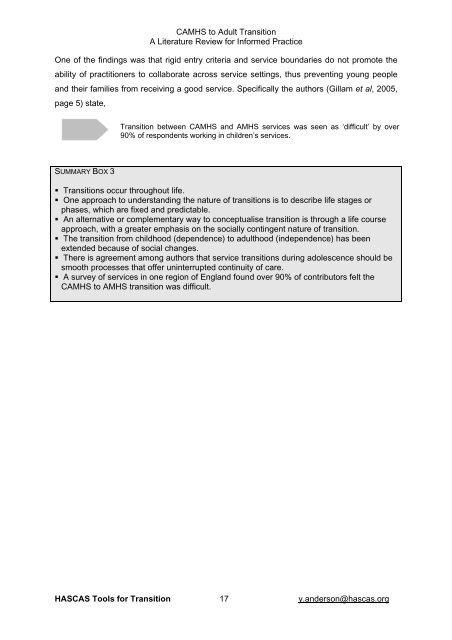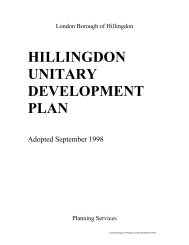Report - London Borough of Hillingdon
Report - London Borough of Hillingdon
Report - London Borough of Hillingdon
Create successful ePaper yourself
Turn your PDF publications into a flip-book with our unique Google optimized e-Paper software.
CAMHS to Adult Transition<br />
A Literature Review for Informed Practice<br />
One <strong>of</strong> the findings was that rigid entry criteria and service boundaries do not promote the<br />
ability <strong>of</strong> practitioners to collaborate across service settings, thus preventing young people<br />
and their families from receiving a good service. Specifically the authors (Gillam et al, 2005,<br />
page 5) state,<br />
Transition between CAMHS and AMHS services was seen as ‘difficult’ by over<br />
90% <strong>of</strong> respondents working in children’s services.<br />
SUMMARY BOX 3<br />
• Transitions occur throughout life.<br />
• One approach to understanding the nature <strong>of</strong> transitions is to describe life stages or<br />
phases, which are fixed and predictable.<br />
• An alternative or complementary way to conceptualise transition is through a life course<br />
approach, with a greater emphasis on the socially contingent nature <strong>of</strong> transition.<br />
• The transition from childhood (dependence) to adulthood (independence) has been<br />
extended because <strong>of</strong> social changes.<br />
• There is agreement among authors that service transitions during adolescence should be<br />
smooth processes that <strong>of</strong>fer uninterrupted continuity <strong>of</strong> care.<br />
• A survey <strong>of</strong> services in one region <strong>of</strong> England found over 90% <strong>of</strong> contributors felt the<br />
CAMHS to AMHS transition was difficult.<br />
HASCAS Tools for Transition 17 y.anderson@hascas.org
















